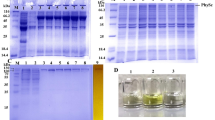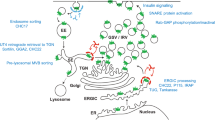Abstract
Human ribokinase (RK) is a member of the ribokinase family, and is the first enzyme responsible for d-ribose metabolism, since d-ribose must first be converted into d-ribose-5-phosphate to be further metabolized and incorporated into ATP or other high energy phosphorylated compounds. Despite its biological importance, RK is poorly characterized in eukaryotes and especially in human. We have conducted a comprehensive study involving catalytic and regulatory features of the human enzyme, focusing on divalent and monovalent metal regulatory effects. Mg2+, Mn2+, and Co2+ support enzyme activity although at different rates, with Mn2+ being the most effective. Analysis of the divalent cation requirement in the wild type enzyme demonstrates that in addition to that chelated by the nucleotide substrate, an activating cation (either Mn2+ or Mg2+) is required to obtain full activity of the enzyme, with the affinity for both divalent cations being almost the same (4 and 8 µM respectively). Besides metal cation activation, inhibition of the enzyme activity by increasing concentrations of Mn2+ but not Mg2+ is observed. Also the role of residues N199 and E202 of the highly conserved NXXE motif present at the active site has been evaluated regarding Mg2+ and phosphate binding. K+ (but not Na+) and PO4 3− activate the wild type enzyme, whereas the N199L and E202L mutants display a dramatic decrease in kcat and require higher free Mg2+ concentrations than the wild type enzyme to reach maximal activity, and the activating effect of PO4 3− is lost. The results demonstrated a complex regulation of the human ribokinase activity where residues Asn199 and Glu202 play an important role.





Similar content being viewed by others
References
Andersson CE, Mowbray SL (2002) Activation of ribokinase by monovalent cations. J Mol Biol 315:409–419
Baez M, Cabrera R, Pereira HM, Blanco A, Villalobos P, Ramírez-Sarmiento CA, Caniuguir A, Guixé V, Garratt RC, Babul J (2013) A ribokinase family conserved monovalent cation binding site enhances the MgATP-induced inhibition in E. coli phosphofructokinase-2. Biophys J 105:185–193
Balestri F, Giannecchini M, Sgarrella F, Carta MC, Tozzi MG, Camici M (2007) Purine and pyrimidine nucleosides preserve human astrocytoma cell adenylate energy charge under ischemic conditions. Neurochem Int 50:517–523
Bork P, Sander C, Valencia A (1993) Convergent evolution of similar enzymatic function on different protein folds: the hexokinase, ribokinase, and galactokinase families of sugar kinases. Protein Sci 2:31–40
Chuvikovsky DV, Esipov RS, Skoblov YS, Chupova LA, Muravyova TI, Miroshnikov AI, Lapinjoki S, Mikhailopoulo IA (2006) Ribokinase from E. coli: expression, purification, and substrate specificity. Bioorg Med Chem 14:6327–6332
Deng G, Shen J, Yin M, McManus J, Mathieu M, Gee P, He T, Shi C, Bedel O, McLean LR, Le-Strat F, Zhang Y, Marquette JP, Gao Q, Zhang B, Rak A, Hoffmann D, Rooney E, Vassort A, Englaro W, Li Y, Patel V, Adrian F, Gross S, Wiederschain D, Cheng H, Licht S (2015) Selective inhibition of mutant isocitrate dehydrogenase 1 (IDH1) via disruption of a metal binding network by an allosteric small molecule. J Biol Chem 290:762–774
Dyguda E, Szefczyk W, Sokalski WA (2004) The mechanism of phosphoryl transfer reaction and the role of active site residues on the basis of ribokinase-like kinases. Int J Mol Sci 5:141–153
Knowles JR (1980) Enzyme-catalyzed phosphoryl transfer reactions. Ann Rev Biochem 49:877–919
Li J, Wang C, Wu Y, Wu M, Wang L, Wang Y, Zang J (2012) Crystal structure of Sa239 reveals the structural basis for the activation of ribokinase by monovalent cations. J Struct Biol 177:578–582
MacCarter D, Vijay N, Washam M, Shecterle L, Sierminski H, St Cyr JA (2009) d-ribose aids advanced ischemic heart failure patients. Int J Cardiol 137:79–80
Maguire ME, Cowan JA (2002) Magnesium chemistry and biochemistry. Biometals 15:203–210
Maj MC, Gupta RS (2001) The effect of inorganic phosphate on the activity of bacterial ribokinase. J Protein Chem 20:139–144
Maj MC, Singh B, Gupta RS (2002) Pentavalent ions dependency is a conserved property of adenosine kinase from diverse sources: identification of a novel motif implicated in phosphate and magnesium ion binding and substrate inhibition. Biochemistry 41:4059–4069
Miallau L, Hunter WN, McSweenwy SM, Leonard GA (2007) Structures of Staphylococcus aureus d-tagatose-6-phosphate kinase implicate domain motions in specificity and mechanism. J Biol Chem 282:19948–19957
Merino F, Guixé V (2011) On the specialization history of the ADP-dependent sugar kinase family. Gene duplication, Prof. Felix Friedberg (Ed.), ISBN: 978-953-307-387-3, InTech, http://www.intechopen.com/books/gene-duplication/on-the-specialization-history-of-the-adp-dependent-sugar-kinase-family
Merino F, Rivas-Pardo JA, Caniuguir A, García I, Guixé V (2012) Catalytic and regulatory roles of divalent metal cations on the phosphoryl-transfer mechanism of ADP-dependent sugar kinases from hyperthermophilic archaea. Biochimie 94:516–524
Ogbunude PO, Lamour N, Barrett MP (2007) Molecular cloning, expression and characterization of ribokinase of Leishmania major. Acta Biochim Biophys Sin (Shanghai) 39:462–466
Omran H, McCarter D, St Cyr J, Lüderitz B (2004) d-ribose aids congestive heart failure patients. Exp Clin Cardiol 9:117–118
Oulhote Y, Mergler D, Bouchard MF (2014) Sex- and age-differences in blood manganese levels in the U.S. general population: national health and nutrition examination survey 2011–2012. Environ Health 13:87
Parducci RE, Cabrera R, Baez M, Guixé V (2006) Evidence for a catalytic Mg2+ ion and effect of phosphate on the activity of Escherichia coli phosphofructokinase-2: regulatory properties of a ribokinase family member. Biochemistry 45:9291–9299
Park J, van Koeverden P, Singh B, Gupta RS (2007) Identification and characterization of human ribokinase and comparison of its properties with E. coli ribokinase and human adenosine kinase. FEBS Lett 581:3211–3216
Pliml W, von Arnim T, Stablein A, Erdmann E, Zimmer H-G, Hofmann H (1992) Effects of ribose on exercise-induced ischaemia in stable coronary artery disease. Lancet 340:507–510
Rivas-Pardo JA, Caniuguir A, Wilson CAM, Babul J, Guixé V (2011) Divalent metal cation requirements of phosphofructokinase-2 from E. coli. Evidence for a high affinity binding site for Mn2+. Arch Biochem Biophys 505:60–66
Segel IH (1975) Enzyme kinetics. Behavior and analysis of rapid equilibrium and steady-state enzyme systems. Wiley, New York
Sigel H (2004) Adenosine 5´-triphosphate (ATP4-): aspects of the coordination chemistry of a multitalented biological substrate. Pure Appl Chem 76:375–388
Sigrell JA, Cameron AD, Jones TA, Mowbray SL (1997) Purification, characterization, and crystallization of Escherichia coli ribokinase. Protein Sci 6:2474–2476
Sigrell JA, Cameron AD, Jones TA, Mowbray SL (1998) Structure of Escherichia coli ribokinase in complex with ribose and dinucleotide determined to 1.8 Å resolution: insights into a new family of kinase structures. Structure 6:183–193
Tozzi MG, Camici M, Mascia L, Sgarrella F, Ipata PL (2006) Pentose phosphates in nucleoside interconversion and catabolism. FEBS J 273:1089–1101
Wu LF, Reizer A, Reizer J, Cai B, Tomich JM, Saier MH (1991) Nucleotide sequence of the Rhodobacter capsulatus fruK gene, which encodes fructose-1-phospate: evidence for a kinase superfamily including both phosphofructokinases of Escherichia coli. J Bacteriol 173:3117–3127
Yang W (2008) An equivalent metal ion in one- and two-metal-ion catalysis. Nat Struct Mol Biol 15:1228–1231
Zimmer HG (1998) Significance of the 5-phosphoribosyl-1-pyrophosphate pool for cardiac purine and pyrimidine nucleotide synthesis : studies with ribose, adenine, inosine, and orotic acid in rats. Cardiovasc Drugs Ther 2:179–187
Acknowledgments
The authors would like to thank to Dr. C. Aliaga (Universidad de Santiago) for using the EPR equipment and her support with our experiments. This work was supported by Fondo Nacional de Desarrollo Científico y Tecnológico (FONDECYT 1110137, Chile) Grant.
Conflict of interest
The authors declare that they have no conflicts of interest in the research.
Author information
Authors and Affiliations
Corresponding author
Electronic supplementary material
Below is the link to the electronic supplementary material.
Rights and permissions
About this article
Cite this article
Quiroga-Roger, D., Babul, J. & Guixé, V. Role of monovalent and divalent metal cations in human ribokinase catalysis and regulation. Biometals 28, 401–413 (2015). https://doi.org/10.1007/s10534-015-9844-x
Received:
Accepted:
Published:
Issue Date:
DOI: https://doi.org/10.1007/s10534-015-9844-x




